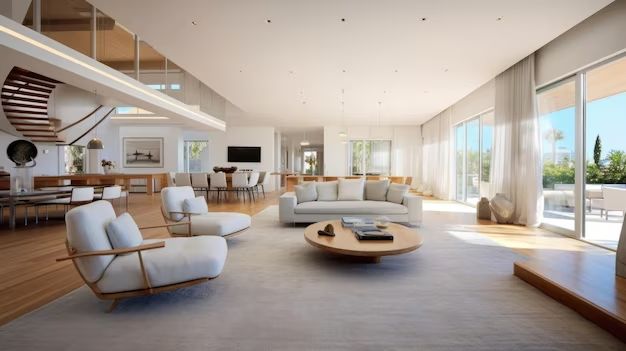Having high ceilings in a house can provide many benefits as well as some potential drawbacks. In this article, we will explore the pros and cons of high ceilings and help you determine if a high ceiling house is right for you.
Page Contents
Pros of High Ceilings
Here are some of the major advantages of having high ceilings in your home:
- Creates a feeling of spaciousness – One of the main benefits of high ceilings is that they can make rooms feel larger and more open. The vertical space draws the eye up and makes even a smaller room appear more expansive.
- Allows more natural light – Higher ceilings allow more room for windows near the top of walls. This enables more natural sunlight to filter into the interior space during the daytime.
- Improves airflow – The additional headroom provides more space for air circulation. This can help keep rooms cooler in the summer and allow hot air to rise instead of getting trapped at lower heights.
- Gives a sense of grandeur – High ceilings evoke a feeling of grandeur and majesty. They are characteristic of palaces, mansions, churches and other structures meant to impress.
- Makes rooms feel less confined – Lower ceiling heights can sometimes make a space feel cramped or claustrophobic. High ceilings counter this effect and create an open, unconfined ambiance.
- Allows taller furniture – With more overhead clearance, larger furniture pieces like tall bookcases, wardrobes and canopy beds can potentially be accommodated.
- Enables higher doorways and windows – Higher ceilings make it possible to have taller windows and doors, which can provide pleasing architectural detail.
- Feels modern and stylish – The lofty aesthetic of high ceilings appeals to modern sensibilities. It’s an on-trend look often seen in contemporary homes and apartments.
- Provides design flexibility – The abundance of vertical space allows for more creativity when incorporating architectural details like moldings, light fixtures, wall art and more.
Cons of High Ceilings
Despite their aesthetic appeal, high ceilings also come with some potential disadvantages:
- Harder to heat and cool – It takes more energy to regulate the temperature in a room with high ceilings. All that extra space needs to be heated in winter and cooled in summer.
- Can feel cold – High ceilings look impressive but can sometimes make a space feel cold or cavernous rather than cozy. Strategic use of lighting is needed.
- More echoing and noise transfer – Sound reverberates more with higher overhead space. This can lead to issues with noises carrying throughout the home.
- Higher cost to build – Constructing higher ceilings requires more materials, time and labor, making it a more expensive architectural choice.
- Lighting challenges – The abundance of height makes lighting the space effectively more difficult. Often multiple lighting layers are needed.
- Harder to decorate – It can be tricky finding furniture and art substantial enough to hold their own visually in a soaring interior space.
- Feeling of disproportion – When ceiling height is not balanced with other proportions in the room, the space can feel disproportionate or ungrounded.
- Difficult to maintain – The increased wall and ceiling area calls for more meticulous cleaning and maintenance to keep surfaces dust-free.
- Resale concerns – Some home buyers may shy away from extremely high ceilings for temperature regulation concerns or costs to decorate tastefully.
Ideal Ceiling Height
When considering ceiling height, aim for the “Goldilocks zone” – not too high, not too low, but just right. Here are some general guidelines for ideal ceiling heights based on room type:
| Room | Recommended Ceiling Height |
|---|---|
| Living Rooms | 9-10 feet |
| Dining Rooms | 9-10 feet |
| Kitchens | 8-9 feet |
| Bedrooms | 8-9 feet |
| Bathrooms | 8 feet |
| Basements | 7-8 feet |
These recommended heights maximize aesthetic appeal and spaciousness while avoiding issues with echos, proportions and excessive heating costs. Ceiling height preferences are somewhat subjective so focus on creating visual harmony and comfort.
Tips for High Ceiling Spaces
Here are some tips for making the most of rooms with lofty overhead space:
- Add visual interest up high – Paint the ceiling a color, install molding or beams, or hang an eye-catching light fixture to draw attention upward.
- Layer lighting – Incorporate lighting at varying heights such as pendant lights, table and floor lamps, and recessed ceiling lights.
- Include tall architectural elements – Floor-to-ceiling draperies, tall shelving units and fireplace surrounds can help ground the space.
- Select substantial furniture – Heavyweight pieces feel more proportional in high-ceilinged rooms compared to delicate furnishings.
- Incorporate textural interest – Plush rugs, textured bedding, and cozy upholstered pieces help balance the hard surfaces and add warmth.
- Arrange furniture to promote conversation – Creating intimate seating arrangements can make a cavernous room feel more welcoming.
- Add ceiling beams or tray ceilings – These structural elements define the overhead space into more proportional sections.
Conclusion
At the end of the day, the ideal ceiling height comes down to your individual needs and preferences. If you love the feeling of airy expanse and the modern style of high ceilings, then this can be a wonderful design choice. Be aware of the potential heating costs, lighting needs, and decor challenges to make the most of the vertical space. For many homeowners, a ceiling height in the 9-10 foot range hits the sweet spot between impressive height and practical comfort and livability. Careful attention to interior design details will ensure your high ceilings feel like an amenity rather than a hassle.
